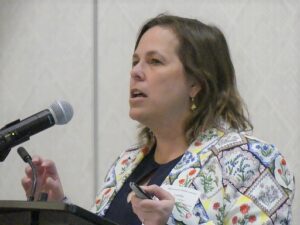
While America’s post-pandemic economy is strong on a number of fronts, there are still some “uncertainties” that cloud the financial picture in the eyes of small businesses and wage earners alike.
That was the message heard by a “Sold Out” crowd of 277 businesspeople and 39 exhibitors representing Elmhurst and 23 other west suburban chambers of commerce at the 21st Annual Economic Outlook Luncheon held at the Hilton/Oak Brook Hills Resort in Westmont on April 6.
Leslie McGranahan, Vice President and Director of Regional Research at the Federal Reserve Bank of Chicago, delivered this year’s Keynote Address.
Titled “Stubborn Inflation and Broader Uncertainty: Economic Outlook for 2023”, McGranahan’s power-point presentation highlight the “robust” growth in America’s economy and labor market, while noting concern over inflation and recent banking collapses.
Prior to his introduction of the Keynote Speaker, John Quigley, President and CEO of the Elmhurst Chamber of Commerce and Industry, thanked Westmont Chamber of Commerce and Tourism Bureau Executive Director Larry Forssberg and his staff for their work in organizing this event—which started in 2003 as a joint venture of the WSCCTB and ECCI.
Carl Tannenbaum, Executive Vice President and Chief Economist at Northern Trust, served as the Keynote Speaker for the first five years, then William “Bill” Strauss presented for 13 years before retiring as Senior Economist and Economic Advisor in the Economic Research Department at the Federal Reserve Bank of Chicago shortly after the February 2020 luncheon, and Anna Paulson, the Fed’s Executive Vice President, Director of Research and Executive Committee member, presented the previous two years.
“Our Keynote Speakers have provided essential insight into the working of the American economy—often predicting Bear-like challenges and Bull-like opportunities a year or more in advance,” stated Quigley, ECCI President and CEO since 1999.
Her presentation started out by highlighting the disparity between key economic factors, such as a higher-than-preferred rate of inflation versus growth in the Gross National Product (GDP) and a two-jobs-per worker labor market ratio versus historically-low unemployment rates.
Designed to lower the inflation rate, increases in the Fed’s lending interest rate of 4.75 to 5.0 percent has had a “dramatic” impact in the housing market, leading to higher mortgage loan rates and a decline in new home construction.
Predictions of an imminent recession after slow GDP growth in the first two quarters of 2022 (1.6 and 0.6 percent) proved baseless as the economy grew by 3.2 and 2.6 percent, respectively, in the last two quarters, and Core Retail Sales grew during the First Quarter of 2023.
Regarding three factors impacting the Consumer Price Index (CPI), the cost of core goods is dropping fast thanks to corrections in the supply chain, shelter costs remain high whether owning or renting, and the cost of core services (sans shelter) is slowly decreasing.
When it comes to the Household Balance Sheet, personal savings is below the pre-pandemic rate and the stock of excess savings is in decline, though still above pre-pandemic rates.
Consumers are feeling stress and concern, and consumer confidence is “less optimist now,” but remains above the pre-pandemic rate.
McGranahan is projecting slow GDP growth for 2023 and 2023, a one-percent uptick in unemployment from 3.5 to 4.5 percent and downward trend in inflation back to two percent.
The luncheon program also included a power-point presentation on the 2026 President’s Cup men’s professional golf tournament to be staged at Medinah Country Club in Medinah, as given by Host Committee Chair Jim Hart, President of Burwood Group.